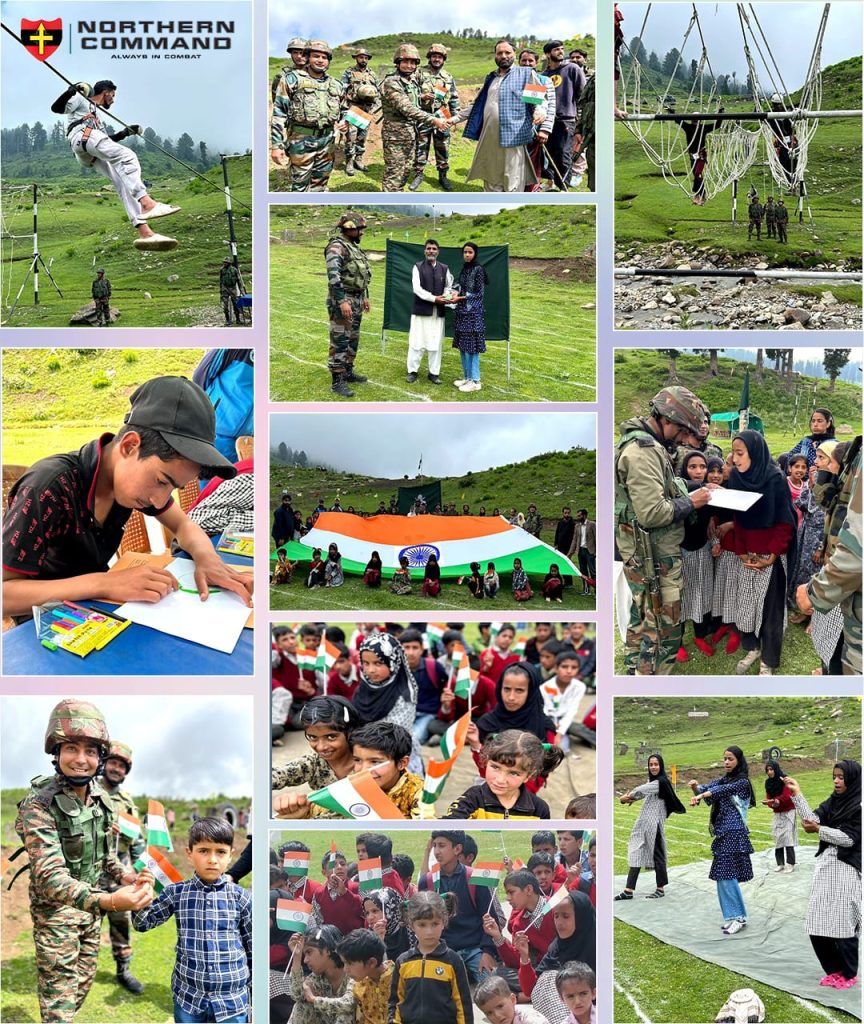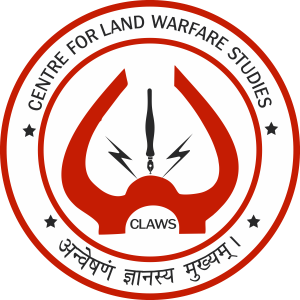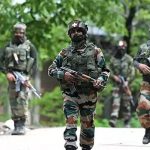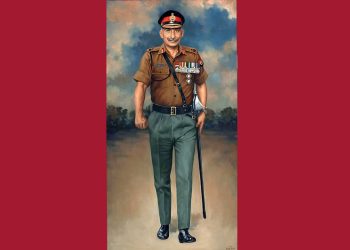
When Moin Javid, Uzair Farooq, Basalat Reyaz, Arbaz Hussain, and Itoo Barika—five students from Army Goodwill School Wuzur—entered the national innovation competition in January 2024, they were among 50 shortlisted projects from schools across India. By Republic Day 2024, these students from rural Kashmir had created history by becoming the only school to win two gold medals at the national level for their groundbreaking innovations: an “IoT-based Home Automation System” that allows remote control of household appliances from anywhere in the world, and an “Automatic Irrigation System” designed to help farmers monitor and control irrigation remotely. Under the guidance of teachers Javid Ahmad and Humaira Rashid, these young innovators demonstrated that with proper mentorship and opportunity through Operation Sadbhavana, students from conflict-affected regions can compete with—and surpass—their peers from India’s most advanced educational institutions.
The above anecdote is nothing but one of countless success stories of Indian Army’s Operation Sadbhavana. However, if the recent report in the faceless organisation – Kashmir Law and Justice Project is to be believed, Operation Sadbhavana is nothing but a facilitator of “international crimes and violations” by the Indian Army in the valley.
The report titled “Goodwill as Bad Faith: Unmasking Operation Sadbhavana in Jammu & Kashmir” contains numerous inaccuracies, unsubstantiated claims, and presents a narrative that significantly mischaracterizes the Indian Army’s Operation Sadbhavana and its positive contributions. The analysis appears to rely on selective interpretation of data and exhibits a tendency toward constructing a skewed perspective, potentially aimed at reinforcing a misleading narrative through recursive citation practices.
While critiques of Winning Hearts and Minds (WHAM) initiatives can contribute constructively to the evolution of strategic approaches, the article in question overlooks a foundational principle that guided counterinsurgency efforts at their peak—namely, the principle of minimal use of force and the recognition of the local population as the centre of gravity in such operations. This oversight may be attributed to a limited engagement with the operational realities on the ground and a predominantly theoretical understanding of the subject. For future scholars, it is important to emphasize that this principle underpinned the Indian Army’s decision to undertake welfare initiatives among alienated communities across various regions in India, and not solely in Jammu and Kashmir, as the article implies.
Operation Sadbhavana, launched in 1998, represents one of the most comprehensive military-led development initiatives globally, encompassing education, healthcare, infrastructure, women’s empowerment, and youth engagement. The program’s success is not merely anecdotal but is backed by verifiable statistics, independent assessments, and community testimonials that demonstrate its profound positive impact on the region’s socio-economic landscape.
The report notably omits substantial empirical evidence that highlights the program’s effectiveness across a range of developmental indicators. Furthermore, it reflects a concerning lack of academic rigor, as it appears to disregard relevant quantitative data that would otherwise contribute to a more balanced and evidence-based analysis. The reality on the ground tells a dramatically different story—one of measurable progress, community upliftment, and genuine nation-building efforts that have transformed thousands of lives across Jammu & Kashmir and Ladakh. This article uses verifiable quantitative and empirical measures to prove the good that Operation Sadbhavana has not only transformed countless live but it has taught the people of valley to dream and achieve greater things.
Educational Excellence: Transforming Lives Through Learning
One of the most impactful components of Operation Sadbhavana is its Army Goodwill Schools (AGS), a network of 43 institutions providing quality education to 16,379 students and employment to 919 teachers and staff. Over 6,000 students have already graduated from AGS in the last two years alone. These schools provide children, particularly those from border and insurgency-affected areas, a stable learning environment, shielding them from the disruptions of conflict.
The Indian Army has executed 1,103 projects in the last two financial years amounting to Rs 62.34 crores. Over 1,150 economically weaker section students were provided scholarships under the Jammu & Kashmir Special Scholarship Scheme (JKSSS), 229 marginalized students were sponsored for higher studies, and 228 students have cleared prestigious exams like JEE, NEET, and UPSC.
Beyond formal schooling, the Army provides books, uniforms, and technology-driven education support, ensuring that remote communities—often neglected due to logistical challenges—have access to quality learning resources. The “Super-40” programme, modelled after the Super-30 initiative, enabled nine students from J&K to pass the highly competitive IIT entrance in 2017, and over 80% have cleared JEE Mains in recent years, signaling the Army’s role in unlocking prestigious academic and professional futures.
Personal stories bring the operation’s impact to life. One young Kashmiri, whose mother passed away leaving the family struggling financially, was able to continue his education thanks to full sponsorship by an Army unit under Operation Sadbhavana. This support covered tuition, hostel fees, books, and resources, enabling him to study away from home during difficult times—a lifeline unimaginable before the initiative.
Healthcare Revolution: Bridging Medical Access Gaps
Operation Sadbhavana addresses healthcare gaps in remote regions through the establishment of multiple health centers and the organization of regular medical and veterinary camps, contributing toward disease-free villages in far-flung areas. Health centers are equipped with ultrasound machines, ECG, oxygen cylinders, and more, ensuring that specialized medical care reaches distant communities.
The Indian Army has executed 421 projects in the last two financial years amounting to Rs 8.19 crores. Over 25,000 locals have benefited from 302 medical camps and over 7,000 animals have been helped by 119 veterinary camps. Free medicines, family planning education, child care, and hygiene awareness are provided, while medical exhibitions on diseases like AIDS and cancer help with local health literacy. Para-medical training for local youth ensures basic care even in emergencies, and artificial limbs are given free to civilians injured by mines and terrorism.
Infrastructure Development: Building Foundations for Progress
Since its inception in 1998, Operation Sadbhavana has overseen expenditure of over ₹450 crores, focusing on both large and small projects targeted at rural upliftment. Initiatives include construction of footbridges, tracks, schools, orphanages, health centers, community centers, solar lights, electrification, check dams, and water supply schemes. The Indian Army has executed 373 projects in the last two financial years amounting to Rs 19.83 crores to include model villages and repaired vast swaths of key public infrastructure destroyed by insurgency.
The Army’s approach in Pir Topa focuses on transparent welfare projects, infrastructure upgrades, healthcare camps, and rebuilding trust through continued presence and partnership with civil administration. This model is being held up as a template for blending security with social progress in far-flung areas. The village, which is home to the Gujjar and Bakkarwal communities, previously lacked basic amenities like roads, hospitals, schools, and electricity. Under the Sadbhavana project, a three-kilometer road is being constructed to connect Topa Pir to a main road, a local school has been upgraded with new desks and fresh paint, and solar street lights have been installed.
Women’s Empowerment: Economic Independence Through Skills
More than 80 community centers created under Sadbhavana provide women with hands-on skills in tailoring, information technology, and entrepreneurship. A total of 241 projects amounting to Rs 6.82 crores have been executed in the last two financial years. These programs have led women to launch bakeries, tailoring businesses, and craft enterprises, fostering sustained financial independence and increasing their roles in local economic life.
Operation Sadbhavana has gone beyond education to focus on economic empowerment, particularly for women. These community centers have enabled women to start small businesses, including bakeries, tailoring units, and craft enterprises—fostering financial independence and boosting social mobility. The Army’s role extends beyond providing skills; it actively facilitates procurement of equipment, market linkages, and mentorship, enabling participants to turn training into tangible career opportunities.
Youth Empowerment and Sports Integration
Numerous vocational training centers have been created to empower youth. These centers teach skills like knitting, tailoring, computer usage, candle and bag making, horticulture, and fashion design, fostering independence. Youth benefit from the creation of Youth Guidance Employment Nodes (YGENs), skill training programs in mechanics, animal husbandry, and tourism, as well as entrepreneurship support.
Sport is emerging as a powerful tool for transformation under Operation Sadbhavana. The Indian Army has established over 100 Khelo India Centers, training young athletes in archery, boxing, and athletics. Leh’s Center of Excellence provides high-performance training, ensuring that local talent gets the same opportunities as their counterparts elsewhere in India. Events like the Khelo India Winter Games and cultural exchange tours offer young people an escape from conflict narratives, fostering a sense of national pride and unity. A total of 399 projects amounting to Rs 10.57 crores have been executed in the last two financial years.
Community Building and National Integration
Operation Sadbhavana recently launched Radio Baramulla 89.6 FM and Radio Uri 90.0 FM to connect with communities otherwise vulnerable to external propaganda. These community radio stations disseminate accurate news, promote local talent, and foster constructive dialogue, helping bridge information divides and bolster social cohesion. In June 2024, these community radio stations go beyond entertainment, serving as platforms for government outreach, local talent promotion, and social cohesion.
As part of integration and enhancing youth experiences, a total of 41 National Integration Tours amounting to Rs 2.90 crores and to address humanitarian needs, a total of 273 projects amounting to Rs 8.74 crores have been executed in the last two financial years.
Operation Sadbhavana is now about self-reliance, not aid. The Army has taken on the role of partner in development, bringing not just relief but long-term investment in health, education, and employment. This redefined military engagement has been fundamental for building lasting trust and stability in remote or conflict-prone border areas. A total of 306 projects amounting to Rs 9.92 crores have been executed in the last two financial years.
Broader National Impact
Caring for the people at the place of deployment is implicit in the way of life of every soldier. Contrary to myopic views in the report, the Indian Army has carried out similar Community Building and Community Engagement activities in other far-flung border areas and militancy-affected regions. In the last two financial years, the Indian Army in the North Eastern States has executed 192 education projects amounting to Rs 13.09 crores, steered 61 National Integration Tours amounting to Rs 4.13 crores, conducted 103 medical & 75 veterinary camps amounting to Rs 8.55 crores, completed 624 Infrastructure Development projects amounting to Rs 59.82 crores, and engaged approximately 11,000 youth in 101 sports events amounting to Rs 9.78 crores.
Conclusion
These fact-based outcomes demonstrate that Operation Sadbhavana, through its emphasis on inclusive development, youth empowerment, community partnership, and security, has catalyzed a transformation in Jammu & Kashmir. Its visible success in education, economic advancement, social integration, and securing the confidence of even remote villages like Pir Topa, underscores both the necessity and the effectiveness of this holistic approach within India’s constitutional framework.
For over two decades, the Indian Army has been quietly reshaping the future of Jammu & Kashmir and Ladakh through education, healthcare, and opportunity. Operation Sadbhavana is not just a military outreach initiative but a sustained effort in nation-building, bridging gaps between security forces and civilians through welfare and development projects.
By focusing solely on alleged violations, the original article misses the complexity of Operation Sadbhavana’s role and its meaningful outcomes. A more balanced approach should reflect both the challenges and the transformative successes of this initiative, which has positively influenced the lives of thousands in Jammu & Kashmir and continues to foster resilience, inclusion, and development in a region once plagued by isolation and violence.














